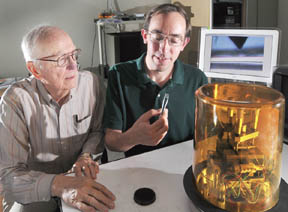
To stretch a supply of salt generally means using it sparingly.
But researchers from Sandia and the University of Pittsburgh were startled when they found they had made the solid actually stretch.
“It’s not supposed to do that,” says Sandia principal investigator Jack Houston (1114). “Unlike, say, gold, which is ductile and deforms under pressure, salt is brittle. Hit it with a hammer, it shatters like glass.”
The research team from Sandia and Pitt was engaged in a preliminary investigation of salt’s properties for desalination studies when the serendipitous discovery was made.
“We were interested in learning what happens when you try to poke salty water through membranes with tiny pores,” says Jack. “So we tried first to characterize the qualities of salt when dry.”
Nathan Moore (1114), investigating with the nanotip of a tool called an interfacial force microscope (IFM) developed by Jack, found with surprise that the brittle substance appeared malleable enough to stay with the tip as it left the surface of the salt, forming shapes that extended into relatively lengthy fingers of separation from the main body.
Examination led by Jianyu Huang (1132) with a transmission electron microscope (TEM) at the Sandia/Los Alamos Center for Integrated Nanotechnologies (CINT) showed that surface salt molecules, like the surface of water when an object is withdrawn, formed a ductile meniscus with the IFM tip as it withdrew from penetrating the cube. But unlike water, the salt meniscus didn’t break from its own weight as the tip was withdrawn. Instead it followed the tip along, slip-sliding away (so to speak) as it thinned and elongated from 580 nanometers to 2191 nm in shapes that resembled nanowires (see image on page 4).
As a possible explanation, offers Jack, “Surface molecules don’t have buddies.” That is, because there’s no atomic lattice above them, they’re more mobile than the internal body of salt molecules forming the salt block.
Another possibility considered was that the TEM electrons (used for viewing the process) break up the salt crystals into tiny grains, allowing rapid atomic diffusion along grain boundaries and permitting nanowires to form and extend. Or the TEM electrons might change sodium from its ionic to its atomic state, where cohesion is weaker and bonding can take place in any direction.
Still, more sparing use of the TEM as an observational tool did not stop the superplastic lengths from occurring. Their lengths increased when the TEM stayed on during the entire experiment, but they were still there and still long when the TEM was used only occasionally and briefly during the process.
‘Totally surprising’
While solder creates a liquid-like surface when modestly heated, the fact that salt showed signs of surface mobility at room temperatures was “totally surprising,” says Jack, who had initially intended to study more conventionally interesting characteristics of the one-fourth-inch square, one-eighth-inch-long salt block.
What this means for oceans, quarries, smog, or deer licks is that salt molecules, if forming nanowires rather than remaining inert, might be causing hitherto unobserved but unpleasant effects.
In a paper published in the May Nanoletters, the researchers write that “understanding the deformation of NaCl [common salt] is particularly important for relating laboratory-scale measurements to geotechnical problems, and for understanding the physiochemical reactions of sea salt aerosols. The latter have been implicated in problems as broad as cloud nucleation, smog formation, ozone destruction, and triggering asthmatic responses in humans.”
Other researchers on this work include Junhang Luo and Scott Mao from the University of Pittsburgh.
In unrelated work that also involved a surprisingly mobile surface, Jack with colleagues Matt Goertz (1132), presently a postdoc at CINT, and X.Y. Zhu at the University of Minnesota, followed up on a centuries-old argument about what makes ice so slippery. Their aim: to map the characteristics of the slickness.
A variety of explanations
The original explanation, by dedicated experimentalist Michael Faraday, that a very thin liquid-like layer of water existed at all times atop ice, was rejected by Lord Kelvin, who agreed that water’s presence did make ice slick but announced — apparently more by fiat than experiment — that its presence was the result of pressure-melting of the ice, says Jack. Later work suggested that heat from friction — as an ice skater or car moved over ice — caused water to appear.
Still, says Jack, it was clearly shown that the weight borne by ice, even from skaters was far below that required to produce enough water to maintain the slipperiness of the thin lubricating film.
Presently, it appears that ice is representative of a self-lubricated material, says Jack. Its thin liquid-like layer of water keeps people, sleds, skates, and other objects sailing above the small but craggy roughnesses of its surface like shaving cream allows a razor to slide above, not on, skin, while mowing down bristles of hair. A wide range of physical exploratory techniques has agreed that this is actually the case. (The term “liquid-like layer” is a technical term used by scientists to describe water that through premelting possesses physical properties between those of water and ice).
Jack and his group confirmed with the IFM yet again that liquid-like water exists atop ice, determining that it creates a kind of capillary-like action with slipperiness that decreases in effectiveness as temperature decreases. The technique gave accurate measurements of the thickness of the aqueous surface layer and the most complete picture to date of its behavior.
This work is currently published in the March 31 issue of the journal Langmuir.
Both research efforts were supported by DOE’s Office of Basic Energy Sciences. The salt research was also supported through the University of Pittsburgh by the National Science Foundation.